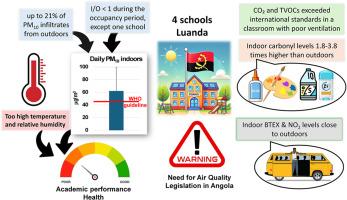罗安达小学室内/室外空气质量
IF 7.3
2区 环境科学与生态学
Q1 ENVIRONMENTAL SCIENCES
引用次数: 0
摘要
尽管对发达国家学校环境中的微粒物质和气体污染物进行了大量研究,但非洲学校的空气质量在很大程度上被忽视了。在这项工作中,在安哥拉罗安达的四所小学的各个教室和室外庭院中,使用光度监测仪和重量采样器评估了大气中颗粒物(PM10)的浓度。实时测量舒适参数、碳氧化物(CO和CO2)和总挥发性有机化合物(TVOCs)。被动采样还用于评估各种气态污染物的水平:苯、甲苯、乙苯和二甲苯(BTEX)、臭氧(O3)、二氧化氮(NO2)和羰基化合物。PM10日浓度(62.0±37.0 μg/m3)超过WHO指导值的天数占68%。室内PM10水平通常低于室外,除了一所建筑条件较差且附近道路未铺设的学校。平均温度和相对湿度水平持续超过建议标准,可能影响学习成绩。二氧化碳和TVOCs水平与占用模式一致,由于通风不良,只有一间教室的浓度升高超过了国际标准。教室里的二氧化氮浓度与室外记录的非常相似,而BTEX水平略高于庭院的测量值。这些化合物主要来自道路交通的排放。教室里的臭氧水平平均比室外低2.3倍。对于大多数羰基化合物,室内浓度是室外测量值的1.8至3.8倍,表明室内存在主动排放源。丁醛、甲醛和己醛是最丰富的羰基化合物。虽然罗安达的BTEX、O3和NO2水平与欧洲学校的报告一致,但甲醛浓度较低,可能是由于气候温和,自然通风更好。本文章由计算机程序翻译,如有差异,请以英文原文为准。


Indoor/outdoor air quality in primary schools in Luanda
Despite the numerous studies on particulate matter and gaseous pollutants in school environments in developed countries, air quality in African schools has been largely neglected. In this work, the atmospheric concentrations of particulate matter (PM10) were evaluated in various classrooms and outdoor courtyards of four primary schools in Luanda, Angola, using photometric monitors and gravimetric samplers. Comfort parameters, carbon oxides (CO and CO2) and total volatile organic compounds (TVOCs) were measured in real time. Passive sampling was also used to assess the levels of various gaseous pollutants: benzene, toluene, ethylbenzene, and xylenes (BTEX), ozone (O3), nitrogen dioxide (NO2), and carbonyl compounds. The daily PM10 concentrations (62.0 ± 37.0 μg/m3) exceeded the WHO guideline value on 68% of the days. Indoor PM10 levels were usually lower than outdoors, except at one school with poor structural conditions and unpaved roads in the vicinity. Average temperature and relative humidity levels consistently exceeded recommended standards, potentially impacting academic performance. CO2 and TVOCs levels followed occupancy patterns, with elevated concentrations exceeding international standards in just one classroom due to poor ventilation. NO2 concentrations in the classrooms were very similar to those recorded outdoors, whereas BTEX levels slightly exceeded those measured in the courtyards. These compounds were primarily attributed to emissions from road traffic. O3 levels in the classrooms were, on average, 2.3 times lower than those outdoors. For most carbonyl compounds, indoor concentrations were 1.8–3.8 times higher than those measured outdoors, suggesting the presence of active emission sources indoors. Butyraldehyde, formaldehyde, and hexaldehyde were the most abundant carbonyl compounds. While BTEX, O3, and NO2 levels in Luanda aligned with those reported for European schools, formaldehyde concentrations were lower, likely due to better natural ventilation supported by the milder climate.
求助全文
通过发布文献求助,成功后即可免费获取论文全文。
去求助
来源期刊

Environmental Pollution
环境科学-环境科学
CiteScore
16.00
自引率
6.70%
发文量
2082
审稿时长
2.9 months
期刊介绍:
Environmental Pollution is an international peer-reviewed journal that publishes high-quality research papers and review articles covering all aspects of environmental pollution and its impacts on ecosystems and human health.
Subject areas include, but are not limited to:
• Sources and occurrences of pollutants that are clearly defined and measured in environmental compartments, food and food-related items, and human bodies;
• Interlinks between contaminant exposure and biological, ecological, and human health effects, including those of climate change;
• Contaminants of emerging concerns (including but not limited to antibiotic resistant microorganisms or genes, microplastics/nanoplastics, electronic wastes, light, and noise) and/or their biological, ecological, or human health effects;
• Laboratory and field studies on the remediation/mitigation of environmental pollution via new techniques and with clear links to biological, ecological, or human health effects;
• Modeling of pollution processes, patterns, or trends that is of clear environmental and/or human health interest;
• New techniques that measure and examine environmental occurrences, transport, behavior, and effects of pollutants within the environment or the laboratory, provided that they can be clearly used to address problems within regional or global environmental compartments.
 求助内容:
求助内容: 应助结果提醒方式:
应助结果提醒方式:


